Why Human Nutrition Matters More Than You Think
Picture this: You’ve just finished a delicious slice of pizza. Within minutes, your body begins an incredible journey of breaking down that food into tiny molecules that will fuel every cell in your body. This amazing process isn’t just fascinating science-it’s literally keeping you alive right now as you read this!
Human nutrition is one of the most practical and relatable topics in IGCSE Biology. Unlike some abstract concepts, you experience nutrition every single day. Every meal you eat, every vitamin you take, every time you feel hungry-it’s all connected to the biological processes we’ll explore in this comprehensive guide.
For IGCSE Biology students, Topic 7 is particularly important because it combines multiple biological concepts: chemistry (enzymes and molecules), anatomy (organ systems), and physiology (how processes work). It’s also a favorite topic for exam questions, so mastering it will significantly boost your grades.
Let’s dive into this fascinating world where science meets your daily life!
What Exactly Is Human Nutrition?
Before we jump into the complex processes, let’s establish what we mean by human nutrition. In simple terms, human nutrition is how our bodies obtain and use the substances we need to survive, grow, and stay healthy.
Think of your body as an incredibly sophisticated factory. This factory needs:
- Raw materials (nutrients from food)
- Energy (from breaking down food molecules)
- Maintenance (vitamins and minerals for various functions)
- Waste removal (getting rid of what we can’t use)
Human nutrition involves several key processes:
- Ingestion – taking food into the body
- Digestion – breaking down complex food molecules
- Absorption – moving nutrients into the bloodstream
- Assimilation – using nutrients in cells
- Egestion – removing undigested waste
The Essential Nutrients: Your Body’s Building Blocks
Macronutrients: The Big Three
1. Carbohydrates – Your Body’s Preferred Fuel
Carbohydrates are like the petrol in your car-they’re the primary energy source for most body functions.
Types of Carbohydrates:
- Simple carbohydrates (sugars): glucose, fructose, sucrose
- Complex carbohydrates (starches): found in bread, rice, potatoes
- Cellulose (dietary fiber): helps with digestion but can’t be digested by humans
Key Functions:
- Provide immediate energy (4 kcal per gram)
- Brain and nervous system fuel
- Muscle energy during exercise
- Spare protein for growth and repair
2. Proteins – The Body Builders
If carbohydrates are petrol, proteins are the construction materials and repair tools.
What proteins do:
- Build and repair tissues
- Make enzymes and hormones
- Form antibodies for immune defense
- Provide energy when needed (4 kcal per gram)
Essential vs. Non-essential amino acids:
- Essential amino acids: Cannot be made by the body, must come from food
- Non-essential amino acids: Can be made by the body from other amino acids
3. Lipids (Fats) – The Concentrated Energy Store
Don’t fear fats! They’re essential for many body functions.
Functions of lipids:
- Concentrated energy source (9 kcal per gram-more than double carbs and proteins!)
- Insulation and protection for organs
- Cell membrane structure
- Absorption of fat-soluble vitamins (A, D, E, K)
- Hormone production
Micronutrients: Small but Mighty
Vitamins: The Biological Catalysts
Comparison of Fat-Soluble vs Water-Soluble Vitamins
| Fat-Soluble Vitamins | Water-Soluble Vitamins |
|---|---|
| A, D, E, K | B complex, C |
| Stored in liver and fatty tissues | Not stored, need daily intake |
| Can be toxic if taken in excess | Excess usually excreted |
| Need fat for absorption | Easily absorbed |
Key Vitamins and Their Functions:
- Vitamin A: Vision, immune function, skin health
- Vitamin D: Calcium absorption, bone health
- Vitamin C: Collagen formation, antioxidant, immune support
- B Vitamins: Energy metabolism, nervous system function
Minerals: The Structural Support
- Calcium: Bones, teeth, muscle function, blood clotting
- Iron: Hemoglobin formation, oxygen transport
- Sodium: Nerve impulses, fluid balance
- Potassium: Muscle contractions, heart rhythm
Water: The Forgotten Nutrient
Water makes up about 60% of your body weight and is involved in:
- Temperature regulation
- Nutrient transport
- Waste removal
- Joint lubrication
- Chemical reactions
The Digestive System: Your Internal Food Processing Plant
The Alimentary Canal: A Journey Through Your Body
Imagine following a piece of food on its journey through your body. This journey takes place in the alimentary canal-a continuous tube about 9 meters long!
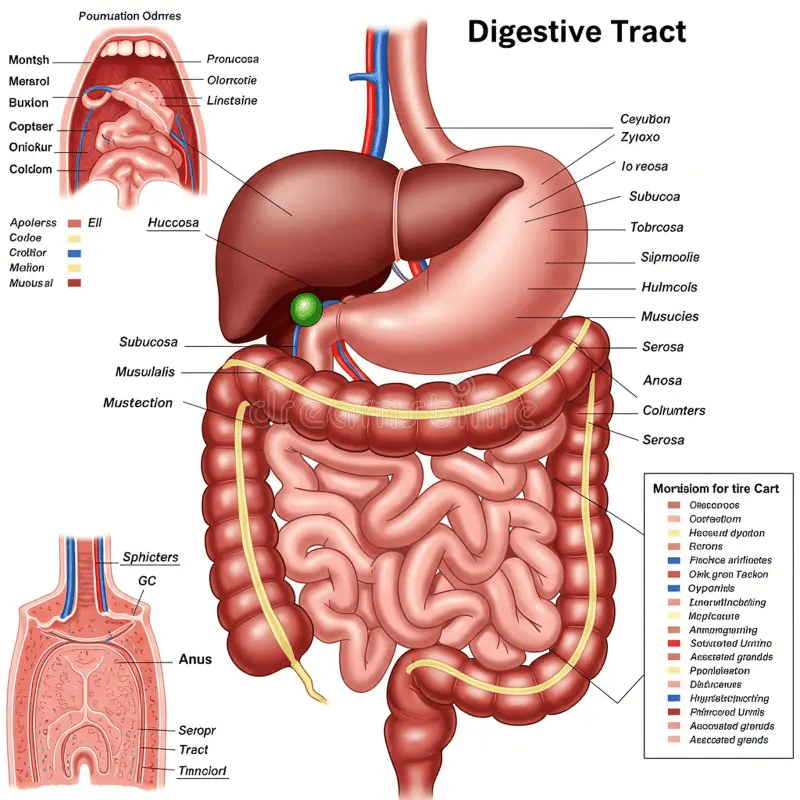
The Journey Begins: Mouth
- Mechanical digestion: Teeth cut, tear, and grind food
- Chemical digestion: Salivary amylase begins starch breakdown
- Formation of bolus: Chewed food mixed with saliva
Down the Tube: Esophagus
- Peristalsis: Wave-like muscle contractions push food downward
- No digestion occurs here-just transport
The Acid Bath: Stomach
The stomach is like a muscular bag that serves as a temporary storage and initial processing center.
Stomach functions:
- Mechanical digestion: Churning action mixes food
- Chemical digestion: Pepsin breaks down proteins
- Acid production: Hydrochloric acid (pH 1.5-2.0) kills bacteria and activates pepsin
- Formation of chyme: Semi-liquid mixture of food and gastric juice
The Small Intestine: Where the Magic Happens
The small intestine is where most digestion and absorption occur. Despite being called “small,” it’s actually about 6 meters long!
Three sections:
- Duodenum: Where most chemical digestion occurs
- Jejunum: Primary absorption site
- Ileum: Final absorption, especially vitamin B12
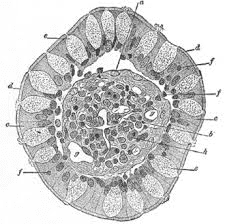
Adaptations for absorption:
- Villi: Finger-like projections that increase surface area
- Microvilli: Tiny projections on each villus cell
- Rich blood supply: Capillaries for nutrient transport
- Lacteals: Lymph vessels for fat absorption
The Large Intestine: Final Processing
The large intestine processes what the small intestine couldn’t absorb:
- Water absorption: Concentrates waste
- Bacterial action: Gut bacteria produce some vitamins
- Waste formation: Undigested material becomes feces
Enzymes: The Biological Scissors
Enzymes are absolutely crucial for digestion. Without them, the food you ate for breakfast would still be sitting unchanged in your stomach!
What Are Enzymes?
Enzymes are biological catalysts-they speed up chemical reactions without being used up in the process. Think of them as molecular scissors that cut large food molecules into smaller, absorbable pieces.
Key Digestive Enzymes
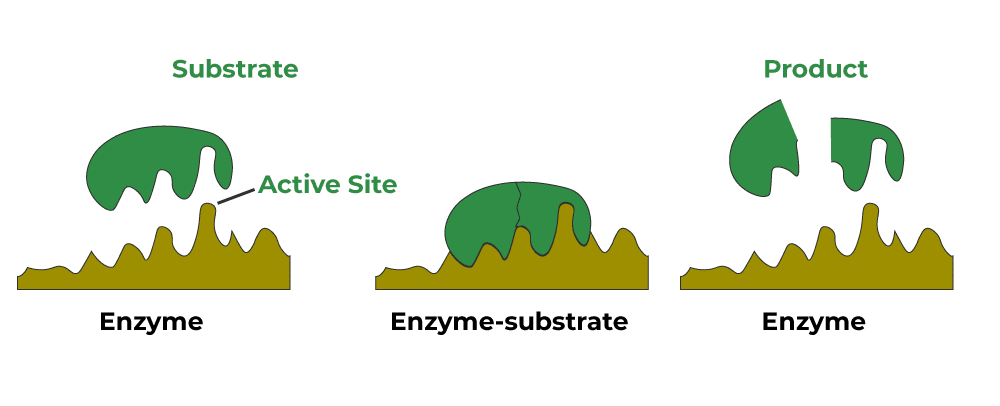
Carbohydrase Enzymes:
- Salivary amylase: Breaks starch → maltose (in mouth)
- Pancreatic amylase: Breaks starch → maltose (in small intestine)
- Maltase: Breaks maltose → glucose (in small intestine)
- Sucrase: Breaks sucrose → glucose + fructose
- Lactase: Breaks lactose → glucose + galactose
Protease Enzymes:
- Pepsin: Breaks proteins → smaller polypeptides (in stomach, pH 1.5-2.0)
- Trypsin: Breaks proteins → smaller polypeptides (in small intestine, pH 8-9)
- Peptidases: Break small peptides → amino acids
Lipase Enzymes:
- Lipase: Breaks fats → fatty acids + glycerol (mainly in small intestine)
Factors Affecting Enzyme Activity
Temperature:
- Too cold: Enzymes work slowly
- Optimal temperature (around 37°C for human enzymes): Maximum activity
- Too hot: Enzymes denature and stop working permanently
pH:
- Each enzyme has an optimal pH range
- Wrong pH changes enzyme shape, reducing effectiveness
- Example: Pepsin works best at pH 2, trypsin at pH 8
Enzyme Concentration:
- More enzymes = faster reaction (up to a point)
- Once all substrate is being processed, adding more enzymes won’t help
The Role of the Liver: Your Body’s Chemical Factory
The liver is one of the most impressive organs in your body. It performs over 500 different functions! In terms of nutrition, here are the key roles:
Liver Functions in Nutrition
1. Bile Production
- Bile salts emulsify fats (like dish soap breaking up grease)
- Stored in gallbladder, released into small intestine
- Makes fats easier for lipase to digest
2. Nutrient Processing
- Glucose regulation: Stores excess glucose as glycogen, releases glucose when needed
- Protein metabolism: Converts amino acids, makes plasma proteins
- Fat metabolism: Produces cholesterol, processes fatty acids
3. Storage
- Glycogen: Glucose storage for energy
- Vitamins: Fat-soluble vitamins (A, D, E, K)
- Minerals: Iron and copper storage
4. Detoxification
- Alcohol processing: Breaks down alcohol into harmless substances
- Drug metabolism: Processes medications
- Ammonia conversion: Converts toxic ammonia to less harmful urea
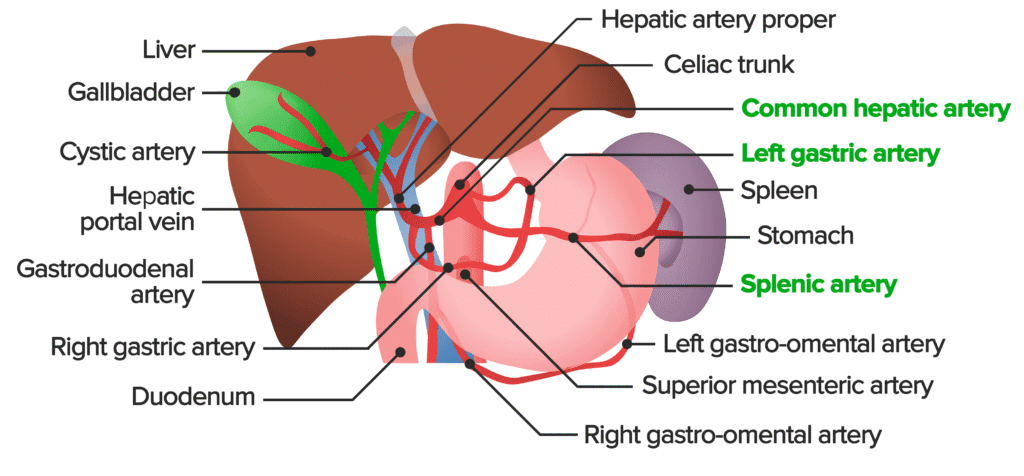
Absorption: Getting Nutrients Into Your Blood
After digestion breaks down food into small molecules, these nutrients need to get into your bloodstream to reach your cells. This process is called absorption.
Where Absorption Happens
Small Intestine: The Main Site
- About 95% of nutrient absorption occurs here
- Specially adapted with villi and microvilli
- Different nutrients absorbed by different mechanisms
Stomach: Limited Absorption
- Water
- Alcohol
- Some medications
Large Intestine:
- Water
- Some vitamins produced by gut bacteria
- Electrolytes
How Different Nutrients Are Absorbed
Simple Sugars (glucose, fructose, galactose):
- Active transport: Requires energy, can absorb against concentration gradients
- Transported directly to liver via hepatic portal vein
Amino Acids:
- Active transport: Various carrier proteins for different amino acids
- Transported to liver for processing
Fatty Acids and Glycerol:
- Passive diffusion: Move through cell membranes
- Reformed into fats inside intestinal cells
- Packaged into chylomicrons (fat transport vehicles)
- Enter lymphatic system first, then bloodstream
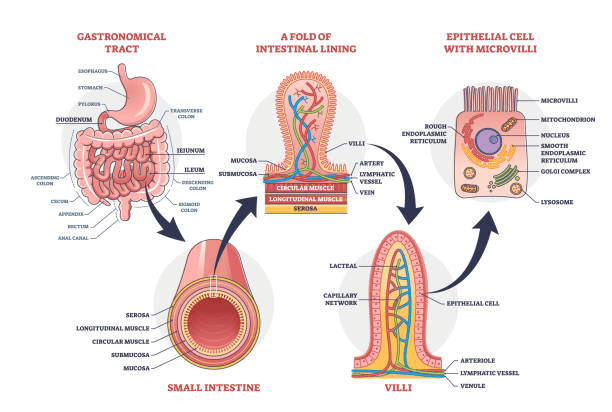
Factors Affecting Absorption
Surface Area:
- Villi and microvilli increase absorption surface area by about 600 times
- Diseases that damage villi reduce absorption efficiency
Transit Time:
- Food must stay in small intestine long enough for absorption
- Too fast (diarrhea) = poor absorption
- Optimal timing allows maximum nutrient uptake
Health of Intestinal Wall:
- Infections, diseases, or medications can affect absorption
- Healthy gut bacteria help with some vitamin production
Common Nutritional Disorders
Understanding nutritional disorders helps you appreciate why balanced nutrition is so important.
Malnutrition: When Things Go Wrong
Protein-Energy Malnutrition:
Kwashiorkor:
- Cause: Adequate calories but insufficient protein
- Symptoms: Swollen belly, skin problems, hair changes
- Common in: Areas where diet is mostly starchy foods
Marasmus:
- Cause: Insufficient calories overall
- Symptoms: Severe weight loss, muscle wasting
- Common in: Areas with food shortages
Vitamin Deficiency Diseases
Scurvy (Vitamin C deficiency):
- Symptoms: Bleeding gums, poor wound healing, fatigue
- Historical significance: Major problem for sailors on long voyages
- Prevention: Fresh fruits and vegetables
Rickets (Vitamin D deficiency):
- Symptoms: Soft, deformed bones in children
- Causes: Lack of sunlight, poor diet, limited outdoor activity
- Prevention: Sunlight exposure, fortified foods
Night Blindness (Vitamin A deficiency):
- Symptoms: Difficulty seeing in dim light
- Progression: Can lead to complete blindness
- Prevention: Orange/yellow vegetables, dairy products
Mineral Deficiency Disorders
Iron-Deficiency Anemia:
- Cause: Insufficient iron intake or absorption
- Symptoms: Fatigue, pale skin, shortness of breath
- Common in: Teenagers (especially girls), vegetarians
- Prevention: Iron-rich foods, vitamin C to improve absorption
Key Chemical Equations and Formulas
Important Digestive Reactions
Starch Digestion:
Starch + Water → Maltose (catalyzed by amylase)
Maltose + Water → Glucose + Glucose (catalyzed by maltase)Protein Digestion:
Proteins + Water → Polypeptides (catalyzed by pepsin/trypsin)
Polypeptides + Water → Amino acids (catalyzed by peptidases)Fat Digestion:
Fats (triglycerides) + Water → Fatty acids + Glycerol (catalyzed by lipase)Cellular Respiration (using absorbed nutrients):
Glucose + Oxygen → Carbon dioxide + Water + Energy (ATP)
C₆H₁₂O₆ + 6O₂ → 6CO₂ + 6H₂O + ATPMemory Tips and Mnemonics
Remember the order of the alimentary canal:
“My Elephant Swallowed Small Large Apples”
(Mouth, Esophagus, Stomach, Small intestine, Large intestine, Anus)
Fat-soluble vitamins:
“All Dogs Eat Kibble” (A, D, E, K)
Essential amino acids cannot be made by the body:
“Essential = External source needed”
Enzyme optimal conditions:
“Body temperature, body pH” (37°C, around pH 7 for most enzymes)
Bile function:
“Bile breaks big fat bits” (emulsification)
Test Yourself: Quick Check Questions
- Which enzyme breaks down starch in the mouth?
- Answer: Salivary amylase
- What increases the surface area for absorption in the small intestine?
- Answer: Villi and microvilli
- Which vitamin deficiency causes scurvy?
- Answer: Vitamin C
- What is the end product of protein digestion?
- Answer: Amino acids
- Where is bile produced and stored?
- Answer: Produced in liver, stored in gallbladder
- What type of transport is used to absorb glucose?
- Answer: Active transport
Quick Revision Notes
Key Processes Summary:
- Ingestion: Taking food in
- Digestion: Breaking down large molecules (mechanical + chemical)
- Absorption: Moving nutrients into blood
- Assimilation: Using nutrients in cells
- Egestion: Removing waste
Essential Nutrients:
- Carbohydrates: Energy (4 kcal/g)
- Proteins: Growth and repair (4 kcal/g)
- Lipids: Concentrated energy (9 kcal/g)
- Vitamins: Biological functions (fat-soluble: A,D,E,K; water-soluble: B,C)
- Minerals: Structure and function
- Water: Transport and reactions
Digestive System Order:
Mouth → Esophagus → Stomach → Small intestine → Large intestine → Anus
Key Enzymes:
- Amylase: Starch → Maltose
- Pepsin: Proteins → Polypeptides (stomach)
- Trypsin: Proteins → Polypeptides (small intestine)
- Lipase: Fats → Fatty acids + Glycerol
Absorption Sites:
- Small intestine: Most nutrients (95%)
- Stomach: Water, alcohol
- Large intestine: Water, some vitamins
Common Exam Questions and How to Answer Them
Question Type 1: Describe and Explain
“Describe the digestion of starch in the human digestive system.”
Answer Structure:
- Start location and enzyme
- Products formed
- Continue to next location
- Final products and where absorbed
Sample Answer:
“Starch digestion begins in the mouth where salivary amylase breaks down starch into maltose. This continues in the small intestine where pancreatic amylase completes the breakdown of starch to maltose. Maltase, found on the surface of intestinal cells, then converts maltose into glucose. Glucose is absorbed into the bloodstream through active transport in the small intestine.”
Question Type 2: Compare and Contrast
“Compare the digestion of proteins in the stomach and small intestine.”
Answer using table format:
| Aspect | Stomach | Small Intestine |
|---|---|---|
| Enzyme | Pepsin | Trypsin, peptidases |
| pH | Acidic (1.5-2.0) | Alkaline (8-9) |
| Products | Large polypeptides | Amino acids |
| Function | Initial breakdown | Complete digestion |
Question Type 3: Explain Adaptations
“Explain how the small intestine is adapted for absorption.”
Key points to include:
- Large surface area (villi and microvilli)
- Thin wall (one cell thick)
- Rich blood supply
- Lymphatic vessels (lacteals)
- Various transport mechanisms
Common Mistakes to Avoid
Mistake 1: Confusing Digestion and Absorption
- Digestion: Breaking down large molecules into smaller ones
- Absorption: Moving small molecules into the bloodstream
- Remember: You must digest before you can absorb!
Mistake 2: Wrong Enzyme Locations
- Pepsin ONLY works in stomach (acidic conditions)
- Trypsin ONLY works in small intestine (alkaline conditions)
- Don’t mix up where enzymes function!
Mistake 3: Forgetting Enzyme Specificity
- Each enzyme breaks down specific substrates
- Amylase breaks down starch, NOT protein
- Pepsin breaks down protein, NOT fat
Mistake 4: Overlooking the Role of Bile
- Bile doesn’t contain enzymes
- Bile emulsifies fats (physical process)
- Makes fats easier for lipase to digest
Mistake 5: Mixing Up Vitamin Types
- Fat-soluble: A, D, E, K (stored in body)
- Water-soluble: B complex, C (need regular intake)
Study Tips for Topic 7 Success
1. Create Visual Connections
Draw your own diagrams of the digestive system. Label everything and use colors to show the path of different nutrients.
2. Use Real-Life Examples
When studying enzymes, think about what happens when you eat specific foods:
- Bread (starch) → amylase → maltose → glucose
- Meat (protein) → pepsin/trypsin → amino acids
3. Practice with Past Papers
Topic 7 questions often follow similar patterns. Practice describing processes step-by-step and explaining adaptations.
4. Make Flashcards
Create cards for:
- Enzyme names and functions
- Vitamin deficiency diseases
- Nutrient functions
- Key definitions
Beyond the Exam: Why This Matters
Understanding human nutrition isn’t just about passing your IGCSE Biology exam-it’s about understanding your own body and making informed decisions about your health.
Real-World Applications:
- Making food choices: Understanding why you need different nutrients
- Reading nutrition labels: Knowing what vitamins and minerals do
- Understanding health news: When you hear about new dietary research
- Athletic performance: How nutrition affects energy and recovery
- Future careers: Foundation for medicine, nutrition, sports science
Current Research Connections:
- Gut microbiome: How bacteria in your intestines affect health
- Personalized nutrition: How genetics influence dietary needs
- Food security: Ensuring adequate nutrition for growing populations
- Sustainable nutrition: Environmental impact of food choices
Your Next Steps to Mastery
Congratulations! You’ve just completed a comprehensive journey through human nutrition. But learning doesn’t stop here.
Immediate Actions:
- Review the Quick Revision Notes – Use them for last-minute review
- Practice the Test Yourself questions – Check your understanding
- Create your own summary – Writing helps consolidation
- Draw the digestive system – Visual memory is powerful
For Deeper Understanding:
- Research current nutrition controversies (low-carb diets, intermittent fasting)
- Explore career paths in nutrition and dietetics
- Investigate your own family’s dietary patterns
- Consider how nutrition affects athletic performance
Exam Preparation:
- Use past papers to practice question styles
- Time yourself on longer questions
- Create mind maps linking different aspects of nutrition
- Form study groups to discuss complex concepts
Connect to Other Topics:
- Topic 6 (Plant Nutrition): Compare human and plant nutrition
- Topic 8 (Transport): How nutrients travel in blood
- Topic 10 (Disease and Immunity): How nutrition affects immune function
Final Thoughts: You’ve Got This!
Human nutrition is one of the most practical and fascinating topics in IGCSE Biology. Every meal you eat involves the incredible processes we’ve discussed-from the moment food enters your mouth to when nutrients reach your cells.
Remember, biology isn’t just about memorizing facts; it’s about understanding the amazing processes that keep you alive. The digestive system you’ve studied is working right now as you read this, processing your last meal and preparing nutrients for your next study session.
As you prepare for your exams, remember that you’re not just learning for a test-you’re gaining knowledge that will help you understand your body and make informed decisions about your health for the rest of your life.
Keep practicing, stay curious, and trust in your ability to master this topic. The detailed understanding you’ve gained here will serve you well not just in your IGCSE Biology exam, but in understanding the incredible machine that is your own body.
Good luck with your studies, and remember-every expert was once a beginner. You’re well on your way to mastering human nutrition!
Recommended –

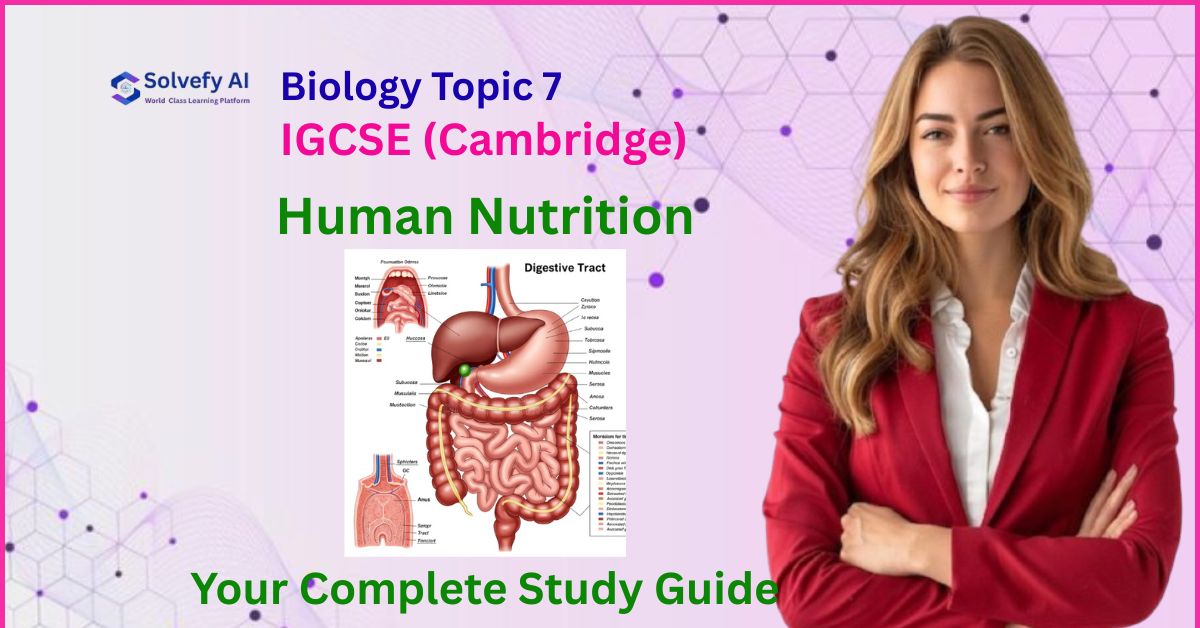
1 thought on “IGCSE (Cambridge) Biology Topic 7: Human Nutrition | Your Complete Study Guide”